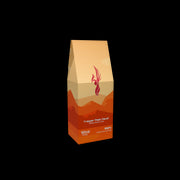Freshly ground coffee beans unlock the rich flavors and aromas that pre-ground coffee simply can't match. When coffee beans are ground, their surface area increases, allowing for better extraction during brewing. The grind size affects how quickly water interacts with the coffee, influencing the flavor profile of your brew.
Different Grind Sizes
Before we get into the nitty-gritty of grinding, it’s crucial to understand the different grind sizes and when to use them:
- Coarse Grind: Resembles sea salt and is ideal for French press and cold brew.
- Medium Grind: Similar to granulated sugar and works well for drip coffee makers and pour-overs.
- Fine Grind: Powdery texture, suitable for espresso machines and AeroPress.
- Extra Fine Grind: Similar to flour and perfect for Turkish coffee.
Choosing the right grind size is key to achieving your desired flavor and brew method.
Tools for Grinding Coffee Beans
Several tools can help you grind your coffee beans, each with its own advantages:
-
Blade Grinder:
- Pros: Affordable and easy to use.
- Cons: Produces inconsistent grind sizes, which can affect extraction.
-
Burr Grinder:
- Pros: Offers consistent grind size, allowing for better extraction. Can be manual or electric.
- Cons: More expensive than blade grinders, but worth the investment for serious coffee lovers.
-
Mortar and Pestle:
- Pros: Allows for full control over grind size.
- Cons: Labor-intensive and not practical for large quantities.
-
Coffee Mill:
- Pros: A traditional option that can produce a range of grind sizes.
- Cons: May require some practice to achieve consistent results.
Step-by-Step Guide to Grinding Coffee Beans
Step 1: Choose Your Coffee Beans
Select high-quality coffee beans that suit your taste. Opt for whole beans to ensure freshness. Consider trying different varieties to discover your favorite flavor profile.
Step 2: Measure Your Beans
Measure out the amount of coffee beans you need. A general guideline is to use about 1 to 2 tablespoons of coffee for every 6 ounces of water. Adjust the ratio according to your preference for stronger or milder coffee.
Step 3: Select Your Grind Size
Determine the grind size based on your brewing method. Refer to the grind size chart above to make an informed choice.
Step 4: Prepare Your Grinder
If you’re using a blade grinder, fill the chamber with your measured coffee beans. For a burr grinder, adjust the settings to your desired grind size before adding the beans.
Step 5: Grind the Beans
-
Blade Grinder: Pulse the grinder in short bursts to avoid overheating the beans and to achieve a more even grind. Shake the grinder gently to redistribute the beans for uniformity.
-
Burr Grinder: Turn on the grinder and let it run until you achieve the desired grind size. Burr grinders typically have a hopper that can hold more beans, making it easier for larger batches.
Step 6: Check the Consistency
After grinding, check the consistency of your coffee grounds. If they’re not uniform, you may need to adjust your technique or grinder settings.
Step 7: Use Your Coffee Grounds
Once you have the desired grind size, use the coffee grounds immediately for the best flavor. If you need to store them, keep them in an airtight container in a cool, dark place to preserve freshness.
Tips for Grinding Coffee Beans
- Invest in Quality Equipment: A good grinder can significantly enhance your coffee experience.
- Experiment: Don’t hesitate to try different grind sizes to find the perfect match for your brewing method and taste preferences.
- Stay Fresh: Grind only what you need for each brew to maximize freshness and flavor.









